Weathering and Erosion Teaching Resources
Browse printable weathering and erosion worksheets, digital activities and more teaching resources to bring this science topic to life in the classroom.
This teacher-created collection of resources is aligned to the Australian curriculum and includes a mix of differentiated and editable options to help you save time on your lesson plans. Each printable and digital resource has been carefully reviewed by a member of our teacher team to ensure it's ready to be used in your classroom!
New to teaching about weathering and erosion, or just looking for some fresh ways to engage your students on the topics? Read on for a primer from our teacher team!
What Is Erosion? A Kid-Friendly Definition
Let's kick things off with a definition that will help you explain these concepts to your students.
Erosion is the process of wearing away or moving pieces of rock, soil or other materials from one place to another. Imagine a river washing rocks off the river's edge and carrying them away with it, and you're picturing erosion happening.
What Causes Erosion?
There are various causes of erosion in nature, from wind to ice to water. Let's take a look at how the different causes affect our environment.
Water Erosion
When moving water — such as the flow of a river or ocean waves — wears away the soil and rocks along its path, it's called water erosion. This can happen when the water flow is too strong or when heavy rains cause flooding.
Wind Erosion
When strong winds blow over exposed soil and rocks, carrying away loose particles and causing abrasion to surfaces, we call it wind erosion. This will often happen in areas with little vegetation or large areas of exposed soil, like in deserts.
Ice Erosion
Another form of erosion occurs when glaciers or frozen water in mountains or polar regions move and carve out valleys and other geological features. This can happen when snow and ice accumulate and compress over time, forming large masses of ice that move slowly downhill.
Human-Caused Erosion
Human activities are another cause of erosion in nature. Activities such as deforestation, mining and construction can all contribute to soil erosion by removing vegetation and changing the natural landscape, which can increase the amount of soil and rocks exposed to erosion-causing forces.
What Is Weathering? A Kid-Friendly Definition
Like erosion, weathering deals with rocks and soil and can involve water, but the two natural processes are distinctly different.
Weathering is the process of breaking down rocks and other materials into smaller pieces. This can happen because of things like wind, rain or even how plants grow in an area over time. Imagine a big rock outside that's been there for a long time. Over time, it might start to crack and break apart because of weathering.
Types of Weathering
Different types of weathering occur in nature, and each has an impact on our planet.
Mechanical Weathering or Physical Weathering
When rocks or other materials break down because of physical forces or things that bump into them, it's called mechanical weathering or physical weathering.
Wind, water and ice can all cause rocks to break down and change over time. Sometimes this happens because of natural events, like when waves crash against a rocky shore or due to freezing and thawing.
Other times mechanical weathering is due to human activity, like drilling into rocks or using heavy machinery to dig.
Chemical Weathering
Chemical weathering is a process in which rocks or other materials break down because of chemicals interacting with them.
For example, water, acids and other chemicals in the environment can cause rocks to break down and change over time. This can happen in nature — like when rainwater reacts with certain types of rocks — or because of human activity — like when we use chemicals to clean buildings or roads.
Sometimes chemical weathering is caused by a mix of natural and manmade chemicals. For example, acid rain is a mixture of water and pollution.
Biological Weathering
Biological weathering is a type of weathering that can involve both physical and chemical processes. Caused by living organisms like plants and animals, this type of weathering often changes the chemical composition of the rock or other material being weathered. For example, tree roots can grow into cracks in rocks and break them apart physically, while bacteria and other microorganisms can produce acids that dissolve the rock chemically.
What Is Deposition? A Kid-Friendly Definition
While erosion may dominate much of your science lesson plans, sediment and particles aren't always being worn away. In fact, sometimes they're going to build up in a particular place.
Teaching students about deposition? Here's a kid-friendly definition that can help!
Sediment and particle deposition is when tiny pieces of rocks, sand, and dirt, called sediment and particles, settle down in a place and stay there.
Think about what would happen if you poured sand or dirt into a jar and didn't turn the jar over to dump it out. The sand or dirt would settle at the bottom of the jar.
The same settling or depositing happens in rivers and lakes too. As the water flows, it picks up tiny pieces of rocks, sand and dirt and carries them along. But when the water slows down or stops moving, the sediment and particles settle down at the bottom of the river or lake, just like in the jar!
Over time, more and more sediment and particles can build up and create new landforms like beaches, deltas or islands!
- Plus Plan
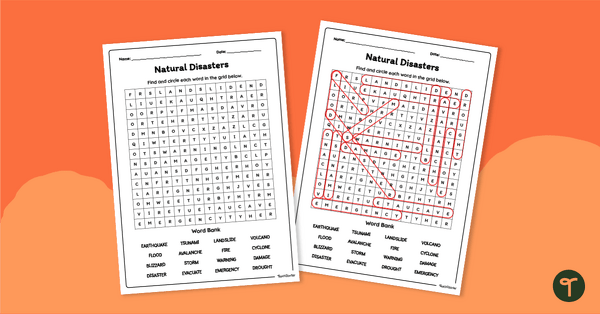
Natural Disasters Word Search
Use a Natural Disasters word search to introduce your students to the vocabulary surrounding these destructive acts of nature.
- Plus Plan
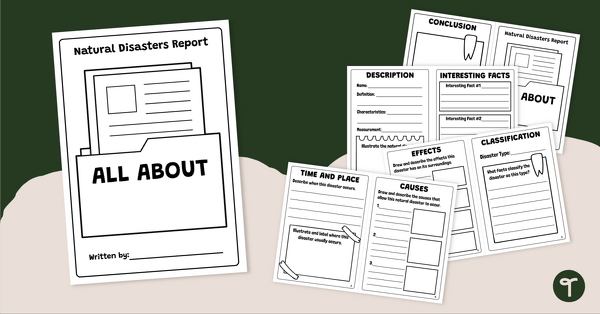
Natural Disasters Report – Mini Book Template
Download this natural disasters information report template to use when teaching informative writing to primary students.
- Plus Plan

Weathering, Erosion and Deposition Colour By Code Worksheet
Guide your students to differentiate between examples of weathering, erosion and deposition with this colour-by-code science worksheet.
- Free Plan
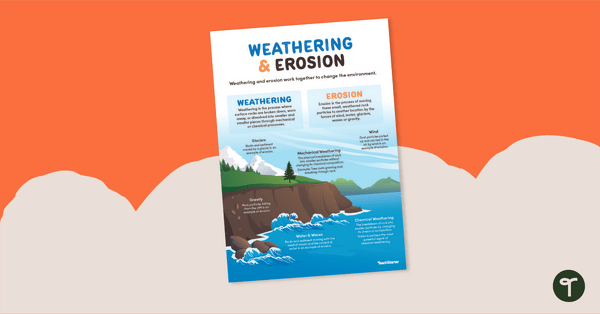
Weathering and Erosion Poster
Learn how weathering and erosion can cause slow changes to Earth’s surface with this printable poster.
- Plus Plan
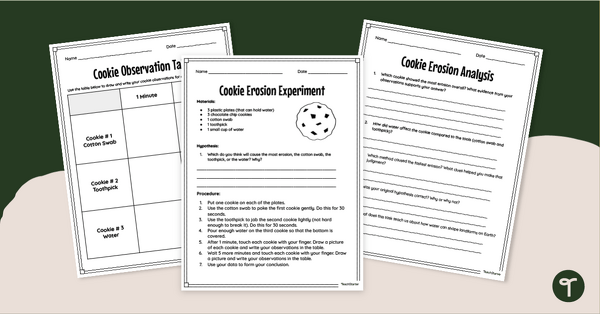
Cookie Erosion Experiment
Discover the effects of water erosion with a printable Cookie Erosion Experiment for kids!
- Plus Plan
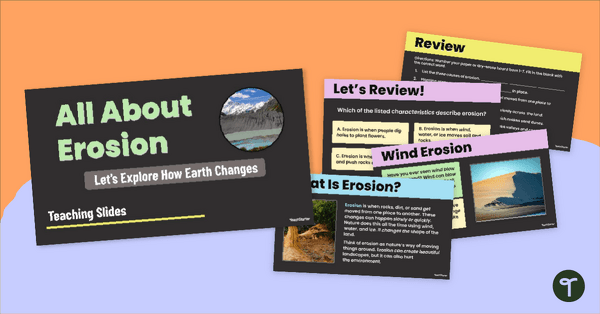
Erosion PowerPoint
Use this Erosion PowerPoint to teach your upper primary students about the way erosion changes the Earth’s surface.
- Plus Plan
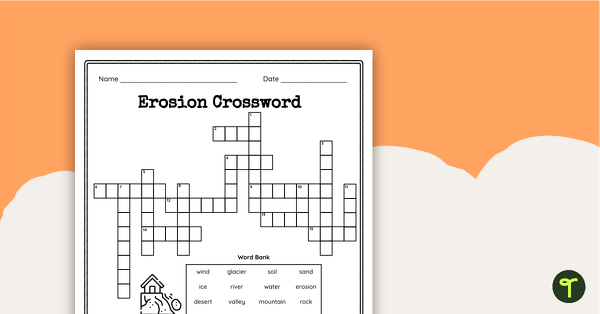
Erosion Crossword Puzzle
Review vocabulary related to erosion with a printable Erosion Crossword Puzzle and answer key.
- Plus Plan
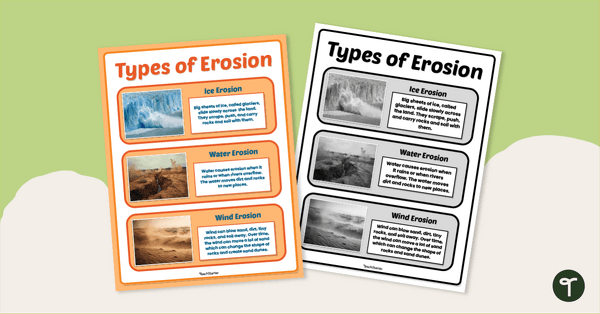
Soil Erosion Poster
Discover how wind, water, and ice change the Earth’s surface with a printable Soil Erosion Poster.
- Free Plan
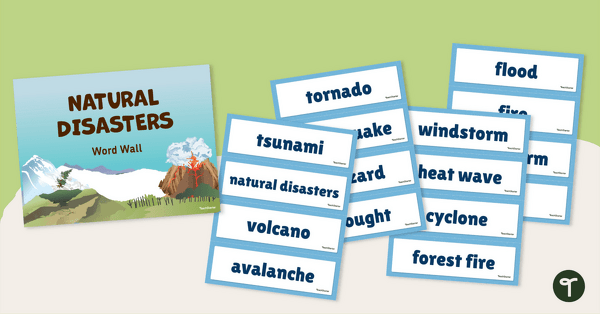
Natural Disaster Word Wall Vocabulary
Use this teacher-created resource to explore natural disaster vocabulary with your primary school students.
- Free Plan
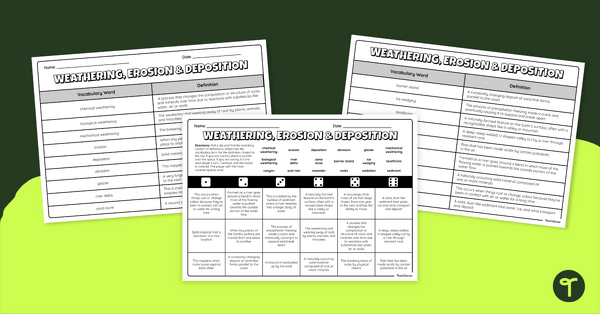
Weathering vs. Erosion vs. Deposition Vocabulary Game
Guide your students to review weathering, erosion and deposition vocabulary words with this free dice game.
- Plus Plan
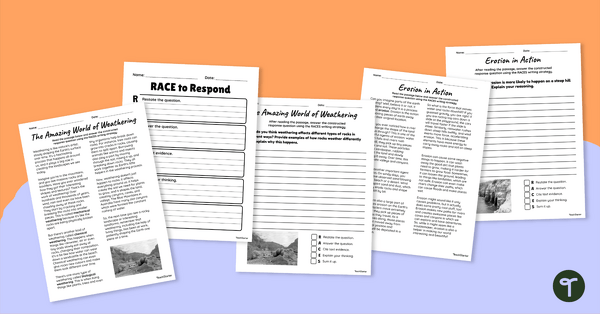
Weathering and Erosion – RACES Writing Strategy Worksheets
Combine reading, writing and science with two worksheets about weathering and erosion using the RACES writing strategy for text evidence.
- Plus Plan
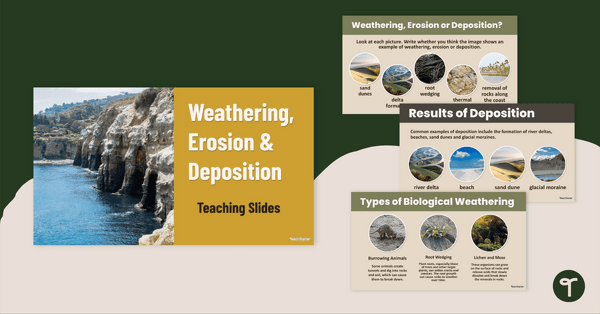
Weathering, Erosion and Deposition – Teaching Slides
Learn about the different types of weathering, effects of erosion, results of deposition and more with this set of teaching slides.
- Plus Plan
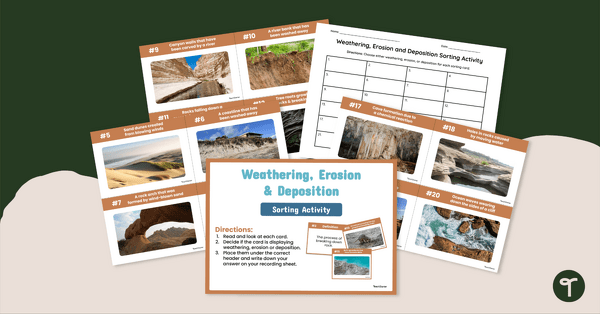
Weathering, Erosion and Deposition – Sorting Activity
Categorise examples of deposition, weathering and erosion with this 24-card sorting activity.
- Plus Plan
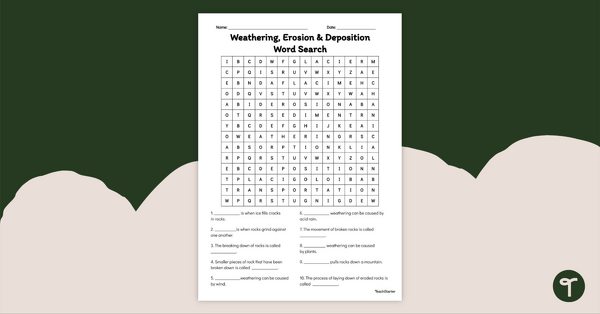
Weathering, Erosion and Deposition – Word Search
Strengthen your students' understanding of weathering, erosion and deposition terms with a vocabulary word search.
- Plus Plan
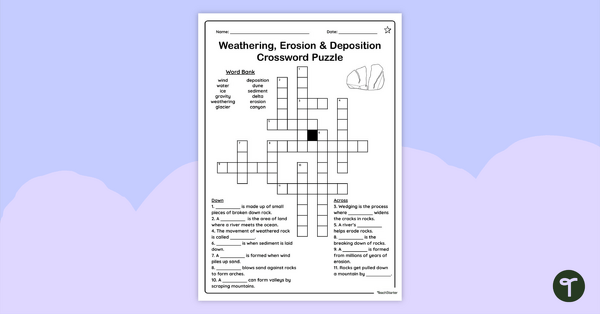
Weathering, Erosion and Deposition – Crossword Puzzle
Review science vocabulary terms associated with weathering, erosion and deposition with a crossword puzzle.
- Free Plan
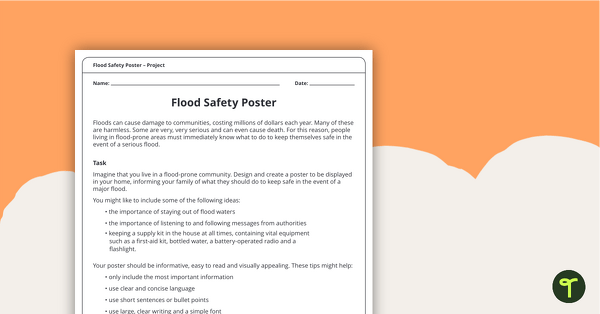
Flood Safety Poster - Design and Create Task
A design and create task for students to demonstrate their understanding of the impact of floods.
- Plus Plan
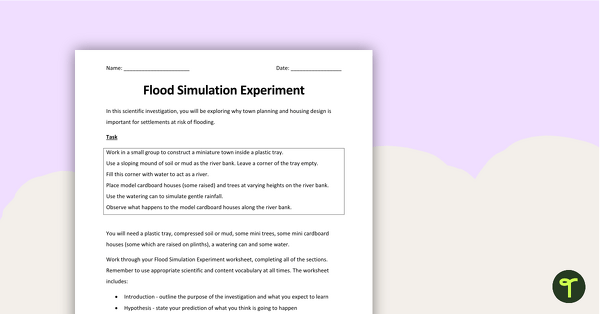
Natural Disasters - Flood Simulation Experiment
A hands-on experiment to use when exploring natural disasters.
- Plus Plan
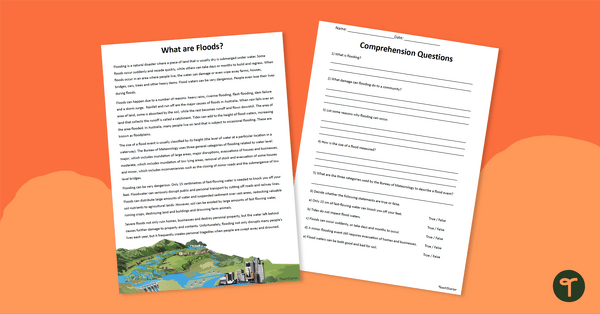
What Are Floods? Comprehension Worksheet
Read and learn about flooding with a printable reading comprehension worksheet.
- Plus Plan
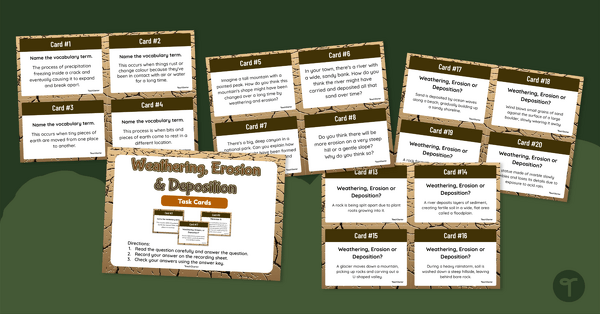
Slow Changes to Earth's Surface Task Cards
Guide your students to answer vocabulary and situational questions about weathering, erosion and deposition with this set of 24 task cards.
- Plus Plan
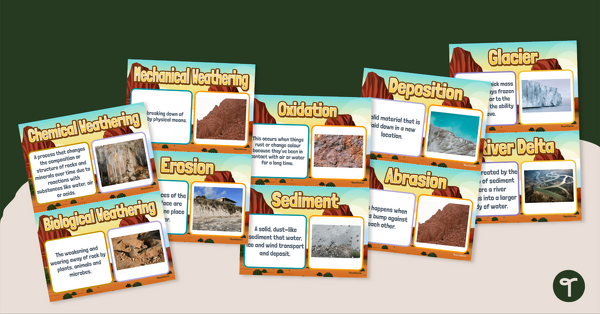
Weathering, Erosion and Deposition Vocabulary Posters
Display this set of science vocabulary posters in your classroom when teaching about weathering, erosion and deposition.
- Plus Plan

Weathering, Erosion and Deposition Matching Game
Challenge your students to identify different slow changes to Earth’s surface with this matching game designed for year 4 and 5 students.
- Plus Plan
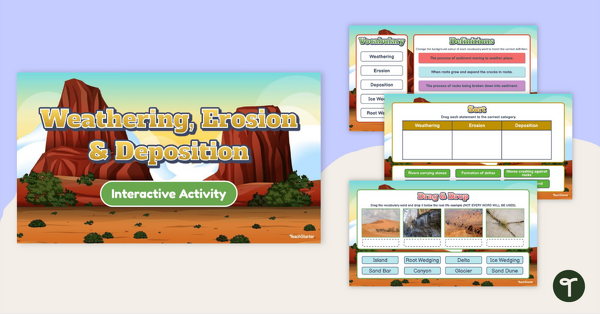
Weathering, Erosion & Deposition Interactive Activity
Use this set of interactive activities to strengthen student understanding of weathering, erosion and deposition concepts.
- Plus Plan
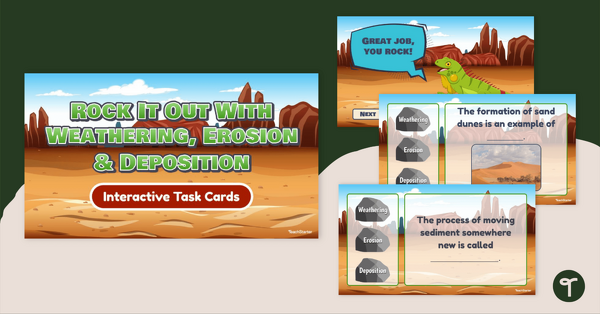
Rock It Out With Weathering, Erosion and Deposition – Interactive Task Cards
Dive into the fascinating world of Earth’s transformations! Download this set of interactive task cards to review weathering, erosion and deposition concepts with your students.
- Plus Plan
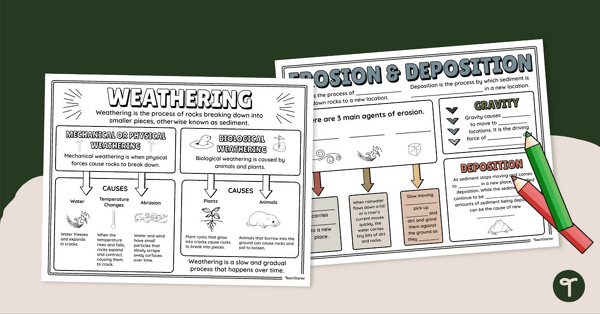
Weathering, Erosion and Deposition Doodle Notes
Engage your students with a set of science doodle notes when learning about erosion, weathering and deposition.
- Plus Plan
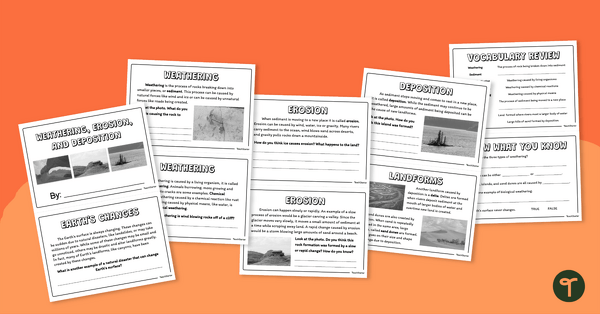
Weathering, Erosion and Deposition Mini-Book
Introduce your students to the different slow changes to Earth’s surface with a printable mini-book designed for year 4 and 5 students.
- Plus Plan
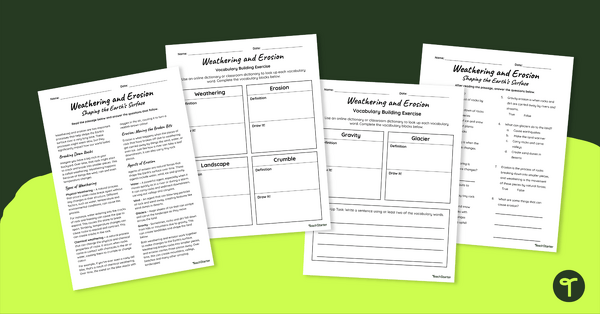
Weathering vs. Erosion Worksheet Pack
Support student understanding of weathering and erosion with this reading comprehension passage, worksheet and accompanying vocabulary activities.
- Plus Plan
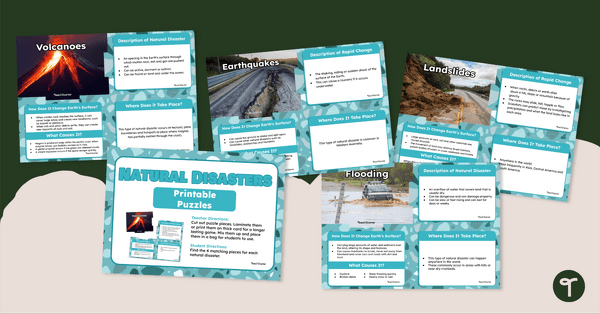
Natural Disasters – Printable Puzzles
Match pictures and facts of various natural disasters with this set of printable science puzzles.
- Plus Plan
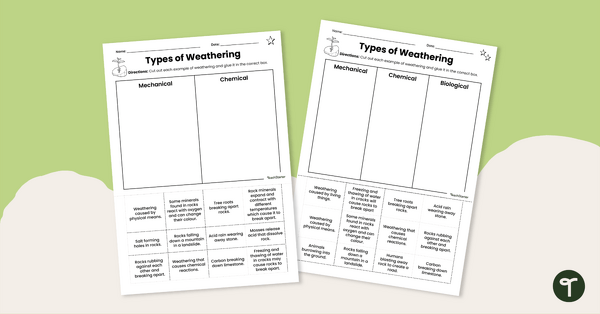
Types of Weathering – Cut and Paste Worksheet
Use this cut-and-paste worksheet when classifying examples that show mechanical, chemical or biological weathering.
- Plus Plan
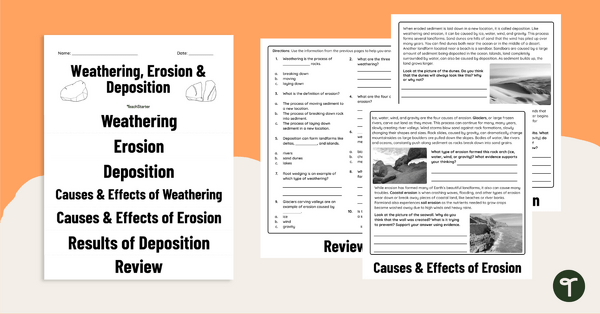
Weathering, Erosion and Deposition Flipbook
Learn about the causes and effects of weathering, erosion and deposition with a printable flipbook.
- Plus Plan

Weathering and Erosion Word Wall Vocabulary
Expand your students' science vocabulary with a weathering and erosion word wall.
- Free Plan
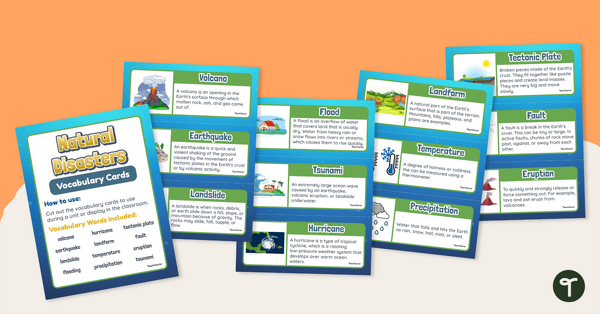
Natural Disasters - Illustrated Vocabulary Display
Reinforce science vocabulary in your classroom with this set of illustrated and annotated natural disaster word wall cards.
- Plus Plan
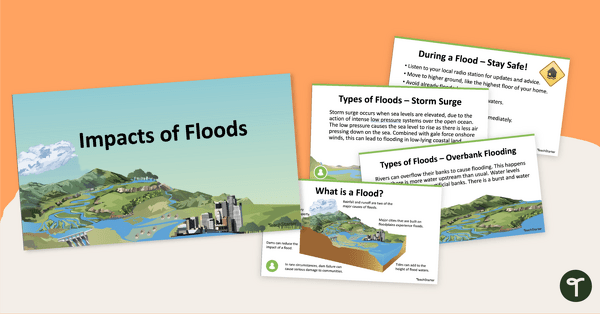
Impacts of Floods PowerPoint
A 17-slide editable PowerPoint template about floods and their impact on communities.